Polycystic ovarian syndrome, or PCOS, is an endocrine disorder that affects one in every ten women of childbearing age. This disease can impact one’s overall health, appearance, and fertility.
Making healthy dietary changes is a great place to start your treatment if you’ve been diagnosed with PCOS or have PCOS symptoms. First, we need to have a basic understanding of what PCOS is.
What is PCOS?
PCOS is a disease that represents hormonal imbalance. It interferes with ovulation, periods, and fertility. Along with these issues, PCOS can lead to metabolic disorders, weight gain, and insulin resistance.
PCOS symptoms usually appear gradually. The first symptoms include oily skin, weight gain, thinning hair, irregular periods, and depression. If you suspect you have PCOS, you should talk to the best gynecologist doctor about these symptoms, especially if you are facing difficulties in getting pregnant.
How Can Nutrition and Lifestyle Changes Help Deal with PCOS?
An exercise regimen, healthy eating, and weight control are the primary treatments for PCOS. These alleviate unpleasant PCOS symptoms and aid in preventing long-term health problems.
Although experts have different opinions on the best diet for PCOS, they all agree that healthy nutrition is essential for symptom management. Here are eight things you can do to stay on track with your dietary lifestyle.
1- Choose Minimal Food but Fresh!
Add a variety of fresh food, which includes fruits, vegetables, dairy products, and foods high in lean protein, such as nuts and seeds. Keep in mind that your food should be non-processed.
If you want to eat healthy but with a color crunch, prepare a power bowl. It is a fantastic and delectable way to consume more energy.
2- Add Whole Grains to Your Daily Diet!
When you are adding grains to your daily diet, choose whole grains made entirely of whole wheat, such as barley, oatmeal, brown rice, low-fat popcorn, and corn. You can try amaranth, buckwheat, millet, quinoa, and teff. These are some less common whole grains, but they provide extra energy.
3- Hydrate Yourself. With Water, Obviously!
Your body needs proper hydration all the time, it’s not even an option. Water is the best hydrating agent, despite a lot of beverage options. If you can’t gulp much water without feeling queasy, squeeze a lemon or lime, an aromatic herb like mint into your water and improve the ambiance.
You can also benefit from milk to improve your hydration levels. It’s better to cut down on sugary drinks like soda, energy drinks, and juices. Diet drinks contain few calories and sugar than regular sodas, but they are still linked to various health issues.
4- Eat Small Portions Throughout the Day
Try eating a modest meal or snack every three to five hours, as opposed to three substantial meals each day. Include a tiny bit of lean protein or vegetable in each meal.
Here are some suitable snack examples for your benefit:
- Snap peas and a single ounce of low-fat cheese
- 1 ounce of skinless, boneless chicken served with a mild salad dressing
- Cottage cheese and grape tomatoes in a half-cup
- A cup of low- or no-sugar yogurt and a spoonful of almonds
- A single hard-boiled egg with carrots and peas
5- Avoid Trans Fats
If your food intake contains high trans and hydrogenated fats, the risk of heart disease increases. Before buying any nutritious food, ensure to read the labels and ingredient lists on the food containers.
6- Try to Eat Fatty Fish Once a Week
Fatty fish contains omega-3 lipids and fatty acids, which are highly beneficial for health. Some examples of fatty fish are salmon, sardines, and herring.
Try to eat fatty fish at least once a week. Keep the fish intake around 8-12 ounces. If you are not a big fish fan, you can get your omega-3s from a plant source. You can get that by adding a tablespoon of ground flaxseed to your yogurt or smoothie, every day.
7- More Fiber, Please!
You should get a minimum of 25 grams of fiber every day. To do that, ensure to include equal portions of whole grains, fruits, and vegetables into your diet.
If you want to check how many fiber grams are in your food, you can look for the nutrition labels or search online for a quick approximation.
The more you pay attention to the food you consume, the more you will know how much good stuff you are eating.
8- Cut Down on Sodium!
Everyone should limit their Sodium intake, and if you have PCOS, you need to be more vigilant.
Try to limit daily salt intake to 2300 mg. To achieve this aim, start by restricting restaurant meals and processed foods in cans and boxes.
While food shopping, look for labels like “reduced Sodium”, “unsalted”, or “no salt added” on your food containers.
Cutting back on salt doesn’t mean your food needs to be bland! Use additional seasonings for your dishes, such as fresh lemon, garlic, onion, flavored vinegar, herbs, and spices.
A Final Word!
Taking extra care of your diet and lifestyle is crucial If you have PCOS. Talk to the best gynecologist doctor about your symptoms and get a detailed view of what you should do about your lifestyle changes.
FAQS
What are the complications of PCOS?
Women with PCOS are at an increased risk for several health problems, including:
- Infertility
- Type 2 diabetes
- Heart disease
- Stroke
- Sleep apnea
- Depression
How is PCOS diagnosed?
PCOS is diagnosed based on a woman’s symptoms and the results of certain tests, such as:
- Blood tests to measure hormone levels
- Ultrasound of the ovaries
What can I do to manage PCOS?
There are a number of things you can do to manage PCOS, including:
- Make healthy lifestyle changes, such as eating a healthy diet, exercising regularly, and losing weight.
- Take medication as prescribed by your doctor.
- Monitor your blood sugar levels regularly.
- See your doctor regularly for checkups.
What are the resources available for women with PCOS?
There are a number of resources available for women with PCOS, including:
- The American College of Obstetricians and Gynecologists (ACOG)
- The National Institutes of Health (NIH)
- The Endometriosis Foundation of America (EFA)
- The PCOS Foundation





